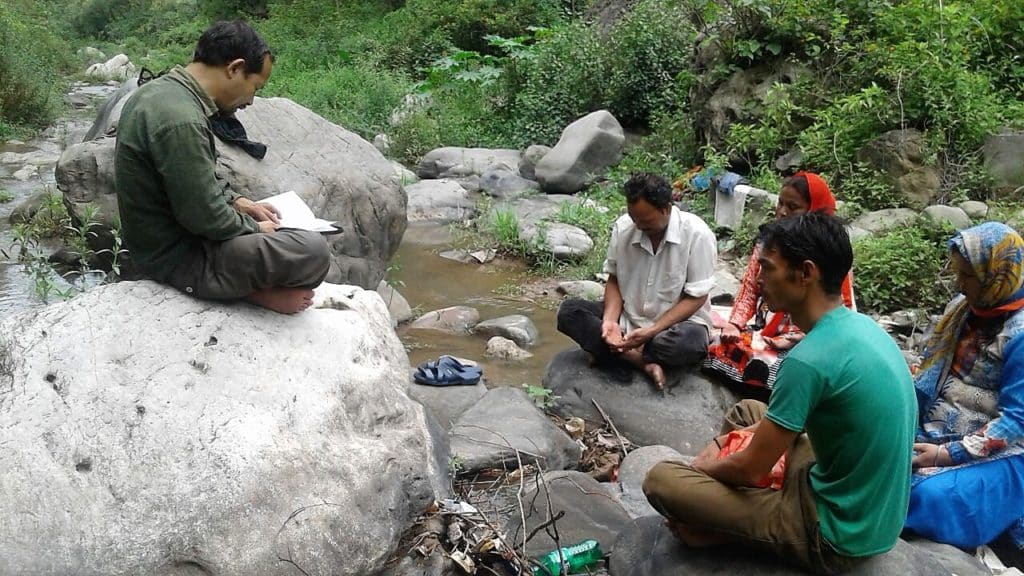There is a quite well-established path for how we as the Church train people to multiply disciples and start churches. Our traditional pathway of gaining ministerial credentials is long. It can take years in seminary or some institution. Could there be a better or more fruitful way?
YWAM FM’s Training Story
Youth With a Mission, is the organization with which I serve. YWAM broke new ground in the 1960’s when Loren Cunningham believed God could use waves of young people in evangelism and missions. With only a few months of intense training, zealous youth went to nations like India, Pakistan, and Afghanistan to pioneer new ministries. They were surprisingly successful! There were failures as well, but God worked.
In the 1980’s, the same mission began planting churches among the unreached. The School of Frontier Missions (SOFM) was born. The training’s three-month classroom phase prepared new workers for cross-cultural ministry. Church planting teams launched out of these schools and went to pioneer places. But again, the process of getting a new worker to the field was long. It took over a year.
As God began to speak about Disciple Making Movements, YWAM Frontier Missions re-examined their pathways. Could there be a faster, more effective way to equip people? Those who went through the one year training were not all that effective in actually starting DMMs. Their heads filled with knowledge, but they were weak on practical skills to make disciples or multiply groups. This led to a significant shift in YWAM FM’s approach to training.
They pioneered shorter trainings like the HMT. Online training was created that enabled many to be equipped. The YWAM Frontier Missions leadership began to put a much greater emphasis on “just in time” or “on the job” training. This is especially true when it comes to training indigenous workers.
Our mindset changed about how to train effective disciple-makers. Consequently, we began to see greater fruit. This shift is still in process.
Old Mindset: Church planters and disciple-makers need years of seminary and other training to be successful, wise, and fruitful.
New Mindset: “On the job” and “just-in-time” training are simple, Jesus-style means of training disciple-makers and leaders
Shanti and Dependra’s Story
Shanti and Dependra* worked in a large Indian metropolis. After doing formal ministry training for six months, they were asked to join a children’s ministry team. Their heart was for church planting. Reaching the lost was their primary passion. But they agreed to do this for a while.
The children’s ministry team worked with slum children. They bathed them, cut their fingernails, and ran feeding programs. Faithfully the couple participated in these projects. In their free time they went and shared the gospel with adults too.

Dependra imagined himself someday as a big pastor preaching to large groups and starting a mega-church. After a few years, they joined another church planting team in their city. The team leader suggested they attend to a short training on Church Planting Movements and DMMs. In two short weeks, their ideas about how to reach their own people and city were radically transformed.
They wrote a simple End Vision plan for multiplication and starting small house churches. Many things were still not that clear. Dependra and Shanti saw, however, that this “rabbit” approach could lead to many thousands of their people coming to Christ.
Laying down the dream of a big church, they decided to work to see a Disciple Making Movement happen instead. Dependra and Shanti went back to their city. They began to put the principles they had learned into practice as best they knew how.
Friends suggested they consider doing a longer six-month training or seminary. There wasn’t one available in their heart language, and their English wasn’t very good. There was also the fact that they didn’t have money for another school. Besides, they wanted to get started and to use these principles with the ten believers they already had.
They kept learning and trying what they learned. A follow up coach visited them every few months giving one day seminars in simple DMM principles they could apply in their context. They had little money, and only a little understanding. But they were doers. Whatever they were taught, they immediately practiced. When they hit obstacles, they talked to their coach.
God did exciting miracles and healings took place through both them and those they were discipling. More people soon believed. They trained some of them to be group leaders and to disciple and teach the new believers. Rather than bringing new people into one church, they encouraged those leading them to faith to start new house groups in those people’s homes.
A year after the initial two-week training, they attended a DMM conference. There they received additional inspiration and input from DMM trainers. This encouraged them and built their confidence.

When they baptized their first believers, they faced persecution from the traditional church. Even some fellow missionaries didn’t understand what they were doing. Still, they remained convinced. They should continue to use Biblical principles and not fear what people said about them.
Within two years, this couple saw a 10-fold increase in the number of Jesus followers! They went from 10 believers to 104 believers. Several churches reached third generation growth.
We shouldn’t think that the only pathway to disciple-making and church multiplication is lengthy training. Nor should we think that only people who have done so, can apply Biblical principles effectively. Shanti and Dependra are an example how God is starting a movement via a just-in-time training path. Encouraged by this modern-day story, lets look back briefly at how Jesus trained his disciples.
How Did Jesus Train the Twelve?
Peter and John attended the Southern Galilee Bible Institute for six months. They then enrolled in the Jerusalem Calvary Seminary and spent four years there. Finally they were sent by Jesus to preach the Gospel to the nations. Is that how it happened? No! Of course not!
How did Jesus train a motley crew of fishermen, tax collectors, and a doctor to turn the world upside down? He modelled life and ministry for them. They followed Him and watched what He did. The disciples listened to his teaching and asked questions. He too asked them questions and explained the things He did in more detail than to the crowds. Jesus sent them out to do some ministry on their own (Luke 9 and 10). They reported back and He gave further input.
The Twelve learned on the job and in the field. Jesus’ disciples learned by watching the Master, doing ministry with Him, then going out and trying it on their own. We call this obedience-based discipleship. He taught. They immediately practiced.
Jesus’ training of the disciples gave them skills; they learned how to share the good news of the Kingdom, cast out demons, heal the sick. It was transformational not informational.
Then, He left them, but not alone. He gave them the Holy Spirit to guide. Jesus trusted this crazy plan for disciple multiplication! And it worked!
But the Advocate, the Holy Spirit, whom the Father will send in my name, will teach you all things and will remind you of everything I have said to you.
John 14:26
How Did Jesus Expect Future Disciples Would Be Trained?
There is nothing wrong with institutes, seminaries, and Bible colleges (or YWAM training schools). I wonder sometimes though, how Jesus would feel about them. I suspect He might ask… “Why are all these devout disciples stuck in buildings learning so much head knowledge?” I think He would wonder, “Why aren’t they out in the fields where the harvest is waiting to be brought in? Who will go to the villages and towns where I am preparing people to come to me, if they are spending all their time here in these institutions?”
If we want to see movements, we must shift our training mindset and strategy. We can equip many, many more people to make and multiply disciples if we keep the training simple, inexpensive, and easily available. Just train in the next step or two. Then send them out to do it. Later, you can then train and coach the faithful and fruitful further.
We Need to Consider Change
If we hold tightly to maintaining training institutions we can experience mission drift. The mission Jesus gave us is to go and make disciples of all nations. This can unconsciously become secondary to the goal of running our programs and graduating students from them. We must evaluate the effectiveness of these training methods. If we want to release DMMs we need to shift our mindset and priorities to a “just-in-time” and “on the job” training model.
Is there a particular training model you feel emotionally connected or loyal to? Perhaps it’s the way you were trained. How open are you to a new way of thinking and working when it comes to equipping workers for the harvest?
Pause a moment and ask God to change your mindset. Ask Him to shine His light on things you are overly loyal to, things that may need to change. The Father will give you courage to make adjustments.
Disclaimer: The above article is not meant to denigrate higher learning or Christian institutions. These can sometimes have their place, particularly for select senior leaders, coaches, and trainers in a movement.
*names are changed.




Comments
Really I believe that our God He can .
So I beg your supporter I can do this ministry as a planter of church.
Please use me
I will do , because I know that I can do all things through Christ who strengthens me.
Praise the Lord.
Your faithful , Michael Mangazine.
Thanks.
I am interested of traveling to come to your office in the USA.
Author
Our office in the USA is basically in someone’s home. We don’t have a big centralized office. Sorry about that.